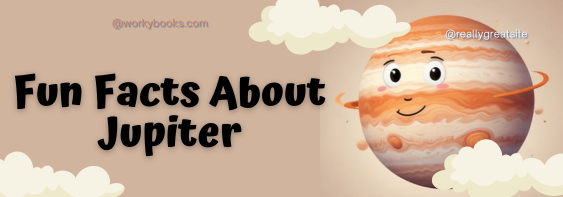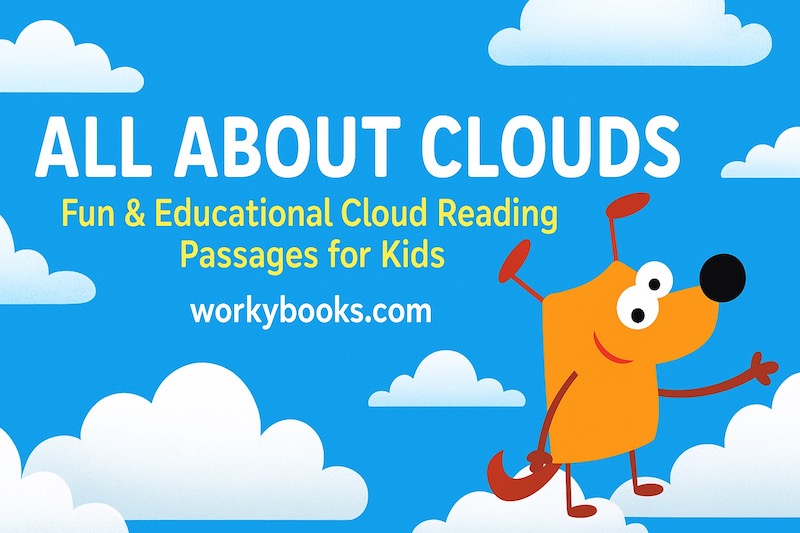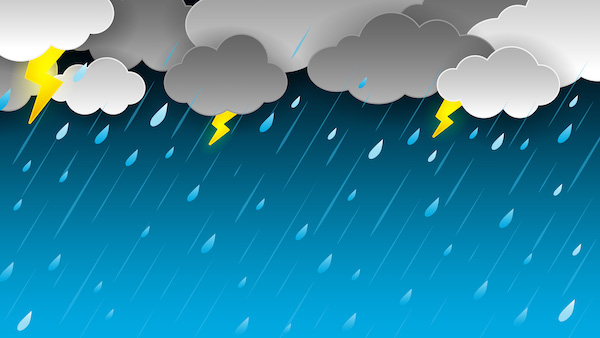Where is the Great Barrier Reef?

The Great Barrier Reef is a vast coral reef system located off the coast of Queensland in northeastern Australia. Stretching for over 2,300 km (1,400 miles) and covering an area of approximately 344,400 square kilometers (133,000 square miles), it is the world’s largest coral reef ecosystem. The reef is composed of over 2,900 individual reefs and 900 islands.
What is the Great Barrier Reef?
Coral reefs are among the most diverse and valuable ecosystems on Earth, supporting a wide array of marine life and providing countless benefits to humans. However, these delicate ecosystems are facing significant threats, particularly from climate change.

Is the Great Barrier Reef a World Heritage Site?
Yes, the Great Barrier Reef was inscribed on the UNESCO World Heritage List in 1981, recognizing its outstanding universal value. The reef meets all four natural criteria for World Heritage listing:
- It represents a major stage of Earth’s history, including the record of life.
- It is an outstanding example representing significant ongoing ecological and biological processes.
- It contains superlative natural phenomena or areas of exceptional natural beauty.
- It contains the most important and significant natural habitats for in-situ conservation of biological diversity.
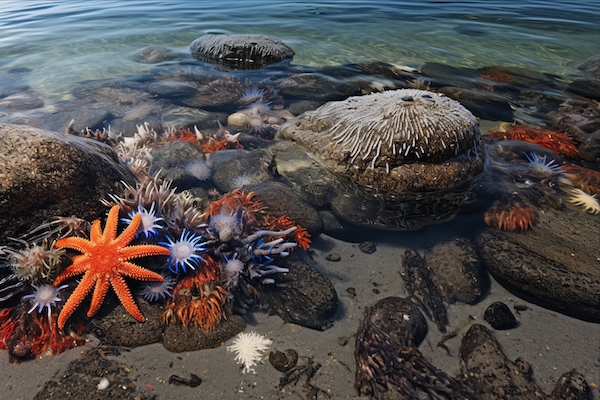
What animals can be found in the Great Barrier Reef?
The Great Barrier Reef is home to an incredible diversity of marine life, from tiny colorful fish to massive marine mammals. Here’s a look at some of the fascinating creatures that inhabit this underwater wonder:
| Animal | Scientific Name | Description |
|---|---|---|
| Clownfish | Amphiprioninae | Small, colorful fish made famous by “Finding Nemo”. Lives among sea anemone tentacles. |
| Green Sea Turtle | Chelonia mydas | Large, herbivorous turtles known for long oceanic migrations. |
| Giant Clam | Tridacna gigas | Largest living bivalve mollusk. Can grow up to 1.2 meters and weigh over 200 kg. |
| Reef Shark | Carcharhinidae | Several species including whitetip and blacktip reef sharks. |
| Coral Trout | Plectropomus leopardus | Colorful predator fish, popular in aquarium trade. |
| Crown-of-Thorns Starfish | Acanthaster planci | Large, spiny starfish that feed on coral polyps. Can damage reef if overpopulated. |
| Humpback Whale | Megaptera novaeangliae | Migrates through the area in winter for breeding and birthing. |
| Dugong | Dugong dugon | Herbivorous marine mammal, often called “sea cow”. Grazes on seagrass beds. |
| Giant Triton | Charonia tritonis | Large sea snail that preys on crown-of-thorns starfish, crucial for reef balance. |
| Parrotfish | Scaridae | Colorful fish with beak-like teeth. Scrapes algae and dead coral, maintaining reef health. |
These are just a few examples of the diverse array of animals that call the Great Barrier Reef home. The reef supports countless other species, from tiny invertebrates to large marine mammals, each playing a unique role in this complex and fascinating ecosystem.
What are the main threats to the Great Barrier Reef?
The Reef faces several significant threats:
- Climate change: Rising sea temperatures, ocean acidification, and more frequent extreme weather events pose severe risks to the reef’s health.
- Poor water quality: Nutrient runoff from agricultural and urban areas can lead to increased algae growth, smothering corals and reducing sunlight penetration.
- Overfishing and destructive fishing practices: These can disrupt the delicate balance of coral reef ecosystems and directly damage the reefs.
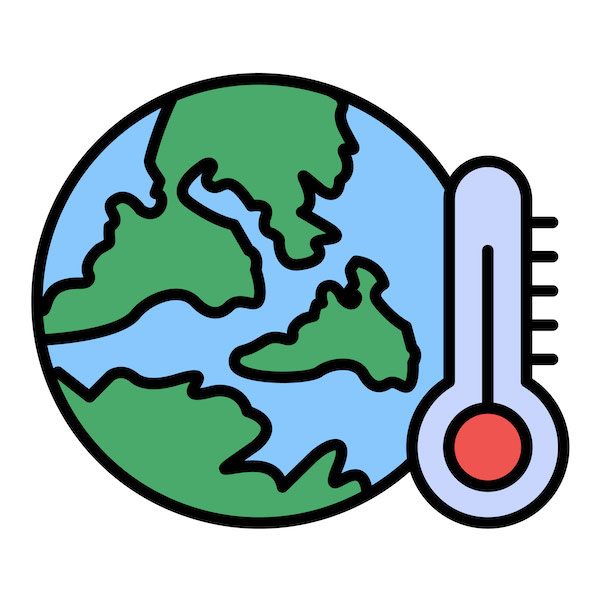
The Great Barrier Reef Worksheet for Grade 4 students
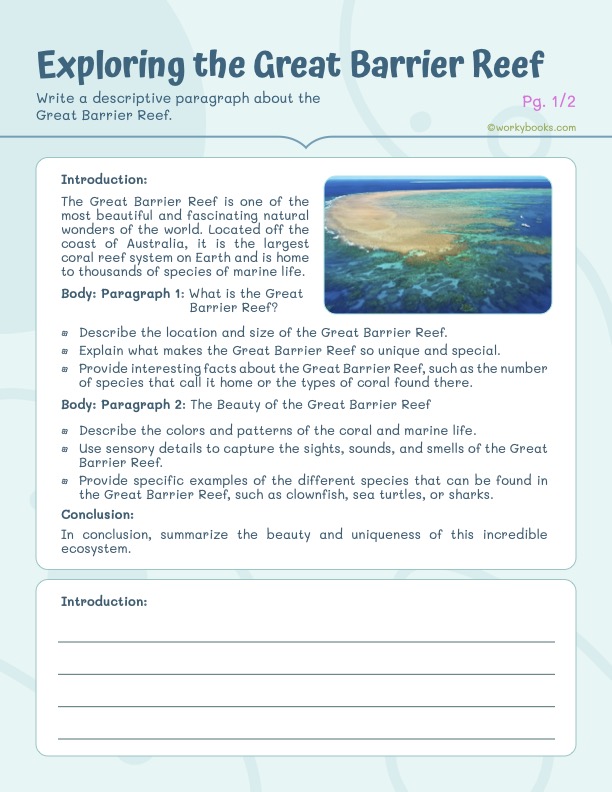
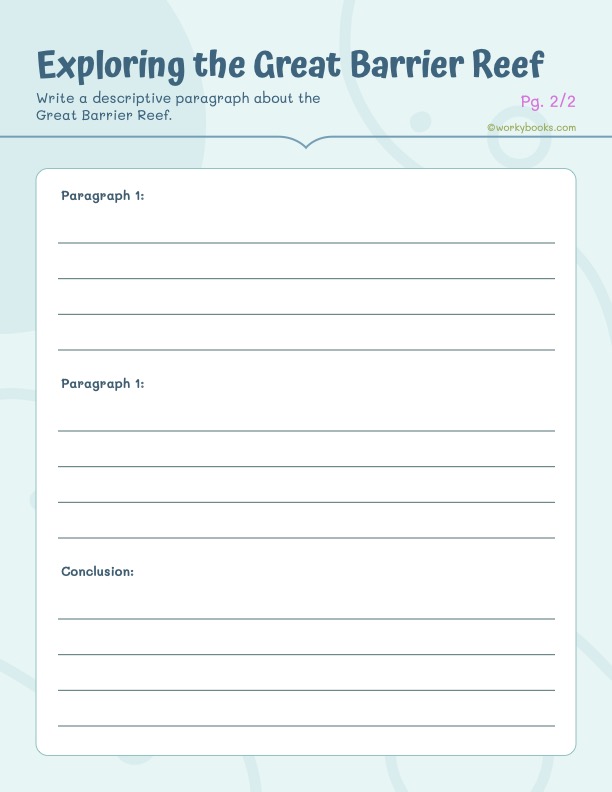
Click here for downloading this free Grade 4 Worksheet
Informational Text with Quiz
Why is the Great Barrier Reef so important to biologists?
The Great Barrier Reef is a very special place in the ocean near Australia. It is so big that you can see it from space! This reef is home to thousands of different sea animals and plants.
The Great Barrier Reef is made up of tiny animals called coral polyps. These polyps build hard skeletons around themselves, which form the colorful reef we see. The reef grows very slowly, taking hundreds of years to get big.Many sea creatures live in the Great Barrier Reef. You can find colorful fish, sea turtles, dolphins, and even giant clams there. Some fish, like the clownfish, make their homes in the soft parts of the coral.
The Great Barrier Reef is important for many reasons. It protects the coast from big waves and storms. It also provides food and shelter for many sea animals. People visit the reef to see its beauty, which helps Australia’s economy.
However, the Great Barrier Reef is in danger. Pollution in the ocean and warming water temperatures can hurt the coral. When the water gets too warm, the coral loses its color and can die. This is called coral bleaching.
Questions
- What is the Great Barrier Reef made of?
a) Rocks
b) Sand
c) Coral polyps
d) Seashells - Why is the Great Barrier Reef important?
a) It provides food for land animals
b) It protects the coast from big waves
c) It makes rain for Australia
d) It produces oxygen for people - What kind of animal makes its home in the soft parts of coral?
a) Sea turtle
b) Dolphin
c) Giant clam
d) Clownfish - What happens when the water gets too warm in the Great Barrier Reef?
a) Fish swim away
b) Coral bleaching occurs
c) The reef grows faster
d) New animals move in
Answers:
1.c) Coral polyps
2.b) It protects the coast from big waves
3.d) Clownfish
4.b) Coral bleaching occurs

